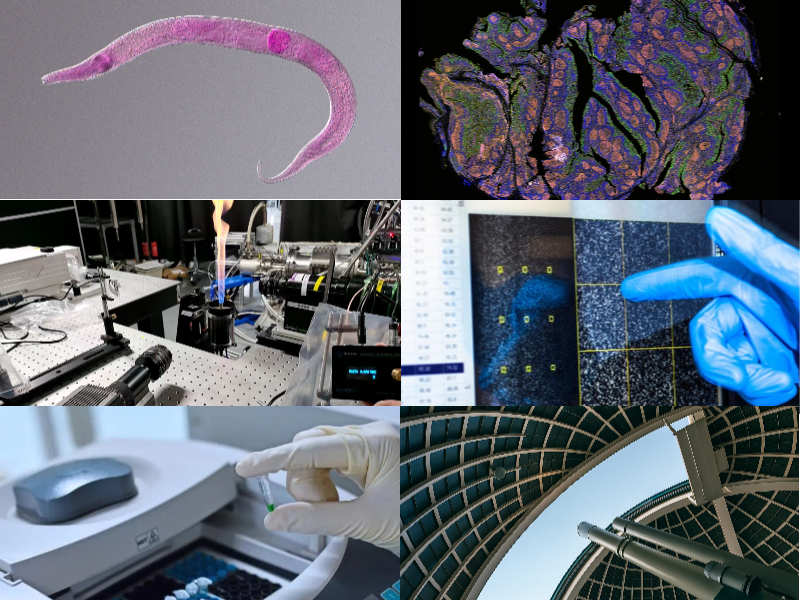In today’s image-driven world, cameras are everywhere—from the smartphone in your pocket to high-end instruments in research labs. But while all cameras capture images, not all are built with the same purpose or precision in mind.
A scientific camera is fundamentally different from the camera you might use for vacations or social media. Beyond differences in megapixels or sharpness, scientific cameras are designed as instruments of measurement and analysis, capturing data, not just pictures.
Understanding how they differ from consumer cameras in terms of sensor technology, image fidelity, and application-specific design is critical for choosing the right imaging system for your needs. Whether you work in life sciences, astronomy, spectroscopy, or semiconductor manufacturing, knowing how these two types of cameras differ helps ensure your imaging results are not only visually impressive but also scientifically valid.
What Is a Scientific Camera?
A scientific camera is not simply a device for capturing pictures—it’s a precision instrument for detecting, quantifying, and analyzing photons. Scientific cameras are engineered for control, accuracy, repeatability, and data integrity.
Key characteristics of scientific cameras include
● Quantitative photon measurement (not just aesthetic image capture)
● Low noise performance to preserve faint signals
● High dynamic range for subtle contrast detection
● Raw data output for scientific processing
● Support for advanced imaging techniques like spectroscopy, fluorescence, and interferometry
Many scientific cameras also measure additional properties of light, such as spectral wavelength, polarization, or phase-essential in fields like microscopy, quantum imaging, and materials science.
Applications include
● Microscopy (e.g., biology, materials science)
● Fluorescence imaging (e.g., cellular process tracking)
● Astronomy (e.g., deep-sky imaging, spectral studies)
● Semiconductor inspection (e.g., wafer defects, pattern detection)

Scientific cameras are often integrated into larger imaging systems and controlled through specialized software for real-time measurement and data analysis.
What Is a Consumer Camera?
A consumer camera is designed for convenience, aesthetics, and versatility. These include smartphones, point-and-shoot cameras, DSLRs, and mirrorless systems. They emphasize image quality for human viewing, rather than scientific measurement.
Design priorities include
-
Ease of use with automatic settings
-
High-resolution images with strong visual appeal
-
In-camera processing to enhance color, contrast, and sharpness
-
Speed for burst modes, autofocus, and video recording
Consumer cameras are ideal for photography, videography, and casual imaging. But they generally lack the precision, stability, and configurability needed for controlled scientific environments.
Scientific vs. Consumer Cameras: Key Technical Differences
|
Feature |
Scientific Camera |
Consumer Camera |
|
Sensor Type |
CCD, EMCCD, sCMOS, advanced CMOS optimized for data integrity |
CMOS optimized for image aesthetics |
|
Sensitivity & Noise |
High sensitivity, low read, and thermal noise |
Lower sensitivity, software-based noise reduction |
|
Dynamic Range & Bit Depth |
High dynamic range for fine grayscale discrimination |
Moderate dynamic range, Sufficient for visual quality |
|
Exposure Control |
Wide exposure range (µs to minutes), precise timing, and frame sync control |
Automatic or limited manual controls |
|
Frame Rate |
Adjustable, with trigger sync capabilities |
Fixed or limited burst/frame control |
|
Data Output |
Raw data, compatible with scientific software, high-speed transfer (USB 3.0, GigE) |
Compressed formats (JPEG/HEIF), minimal control over data output |
|
Applications |
Microscopy, astronomy, spectroscopy, semiconductor inspection, R&D |
Photography, video, and casual use |
Sensor Technology Breakdown
CCD (Charge-Coupled Device)
-
Advantages: Uniform signal readout, low read noise, excellent for long exposures.
-
Drawbacks: Slower read speeds, higher power consumption.
-
Use Case: Astronomy, low-light microscopy.
EMCCD (Electron-Multiplying CCD)
-
Adds an amplification stage to detect single-photon events.
-
Ideal For: Ultra-low-light imaging (e.g., single-molecule tracking, high-sensitivity spectroscopy).
CMOS (Complementary Metal-Oxide-Semiconductor)
● Widely used in consumer electronics.
● Strengths: Low power usage, fast readout, affordable.
● Limitations: Higher noise, non-uniform pixel response (in consumer models).
Some industrial and scientific CMOS sensors are optimized for precision imaging, such as those used in machine vision and real-time inspection.
Example: Tucsen’s TrueChrome 4K Pro Microscope Camera is a camera based on a CMOS sensor that delivers exceptional clarity and real-time 4K imaging for microscopy applications.
sCMOS (scientific CMOS)
-
Combines the benefits of CCD and CMOS: high speed, low noise, and wide dynamic range.
-
Ideal for modern scientific applications like fluorescence microscopy, beam profiling, or semiconductor inspection.
Example: Tucsen’s Dhyana 400BSI V3 sCMOS camera offers ultra-low read noise, high resolution, and compact design for demanding microscopy workflows.
Performance Considerations
Sensitivity & Noise
Scientific cameras suppress image noise (read, thermal, and dark current) to detect low-light signals critical in fluorescence or astronomy. Consumer cameras often rely on noise-reduction algorithms that blur or distort real signals, making them unsuitable for quantitative analysis.
Dynamic Range & Bit Depth
Scientific sensors can capture subtle intensity differences thanks to the higher dynamic range. This allows differentiation between dim signals and brighter features. Consumer sensors are optimized for contrast and appearance, not measurement fidelity.
Exposure Control
Scientific cameras offer microsecond to multi-minute exposure settings with trigger control. This precision is essential for time-resolved imaging or long-exposure astrophotography. Consumer cameras rarely allow such fine control.
Frame Rate & Synchronization
Scientific cameras support hardware triggering, multi-camera sync, and high-speed capture with consistent frame timing—important in live-cell imaging or machine vision. Consumer cameras prioritize visually pleasing video quality and faster shutter speeds for casual use.
Data Output and Connectivity
Scientific cameras provide uncompressed, raw data to ensure integrity in scientific processing (often via USB 3.0, GigE, or CoaXPress). Consumer devices prioritize ease of use, outputting compressed formats with in-camera color and gamma adjustments.
Common Applications: Scientific vs Consumer Cameras
Scientific Camera Applications
● Life Sciences & Microscopy: High-resolution, low-light, and time-lapse imaging for cellular processes.
These types of cameras—like microscopy cameras—are typically integrated with advanced fluorescence microscopy systems. They require high-sensitivity performance—including high quantum efficiency and low readout noise—to minimize photobleaching and photodamage to biological specimens.

● Astronomy: Long-exposure imaging, solar and planetary spectroscopy, and photometric analysis.
● Spectroscopy: High precision intensity detection across wavelengths for emission, absorption, or Raman studies.

● Beam Profiling: Analyzing laser beam shapes and intensity distributions with real-time feedback.
● Semiconductor Inspection: Nano-scale defect detection with high resolution, low noise, and DUV sensitivity.
Consumer Camera Applications
Conversely, consumer cameras are aesthetic and simple to use. Typical uses are:
● Photography & Videography: Events, portraits, travel, and lifestyle shooting.
● Social Media: Content optimized for display on screens, emphasizing appearance over accuracy.
● General Documentation: Casual image capture for everyday use, not scientific study.
No matter if you're strolling through pathbreaking research or videoing daily situations, choosing a camera starts with understanding what it's intended for.
Conclusion
While consumer cameras excel at making images look good, scientific cameras are designed to make images meaningful. They are precision instruments built for exacting tasks—whether you’re mapping galaxies, tracking proteins inside living cells, or inspecting semiconductors on the nanoscale.
Understanding these differences empowers researchers, engineers, and developers to choose the right imaging tools—not just to capture an image, but to extract truth from light.
FAQs
Q1: What is the main difference between a scientific camera and a consumer digital camera?
Scientific cameras measure and quantify light precisely, offering high data integrity. Consumer cameras are designed to create visually appealing images, often using automatic and aesthetic-oriented processing.
Q2: What makes sCMOS better than CCD or regular CMOS?
sCMOS delivers a unique combination of low noise, fast speed, high dynamic range, and spatial resolution—ideal for many modern scientific tasks.
Q3: Why are scientific cameras used in semiconductor inspection?
They offer the precision, low noise, and wavelength sensitivity necessary for detecting micro- and nano-scale defects under tightly controlled lighting and optical conditions.


 2025/07/24
2025/07/24







